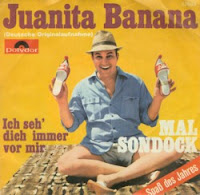 Trini Lopez
Trini Lopez -
Up To Now(Bobby Susser - Marty Cooper - Terry Sue Pinter)
1967
Single on Reprise #0574
I could take or leave most of
Trini Lopez's hits. They were mainly pepped up versions of familiar songs, often showcased with nightclub audience noise:
If I Had A Hammer,
America, Lemon Tree,
I'm Comin' Home Cindy... Okay, I could take the songs, but I could leave the party-time sound effects.
Then came
Up To Now. This was a straight-ahead pop production with no hand clapping shenanigans.
Up To Now didn't need any vicarious excitement: it screamed out excitement right from the opening bars, through a rhythmic drum, trumpet and strings arrangement. [
Listen]
It's the type of song you can imagine the
Northern Soul fans taking up. But (oddly, I've always thought) nobody much took it up at all. It's one of those first-rate songs that, in spite of everything, has ended up as an obscurity.
Up To Now had the same arranger and producer as the hits,
Don Costa (1925-1983).
Costa started out as a guitarist and continued to record in his own name (
Never On Sunday, 1960, #19 USA), but he was renowned mainly as an arranger, producer and conductor, notably for
Paul Anka,
Sammy Davis Jr,
Steve Lawrence and Eydie Gorme,
Frank Sinatra and, yes,
Trini Lopez.
Space Age Pop
sums up Costa this way:
He liked very dense arrangements - Billy Byers [pianist]
called him "the Puccini of pop," saying that his arrangements were "seething with melody." That sounds to me like the
Don Costa of
Up To Now.
As to the writers,
Marty Cooper was Tico of high school vocal group
Tico & The Triumphs (see their
history at DestinationDoowop.com). They put out some singles 1961-62 that were produced by the yet-to-be-famous
Paul Simon with his friend
Bobby Susser.
After
Paul Simon moved on to other projects,
Marty Cooper and Bobby Susser teamed up to write and produce: one of their compositions,
Kiss Me Now, was released on Phil Spector's Phi-Dan label by
Florence De Vore (1965) and was on
Diana Ross's self-titled album in 1976 . In 1972
Bobby Susser and
Lou Stallman's group
Think had a #23 USA hit with their controversial anti-drug composition,
Once You Understand.
This is the same
Bobby Susser who is nowadays a successful writer and performer of children's songs: he has a website at
BobbySusser.com, but his
Wikipedia entry gives more information and a good overview of his varied career.
---⭐Update on co-writer
Terry Sue Pinter: she was married to
Marty Cooper. See my
follow-up post.




























